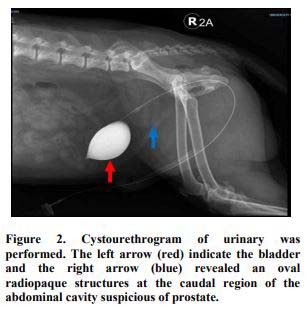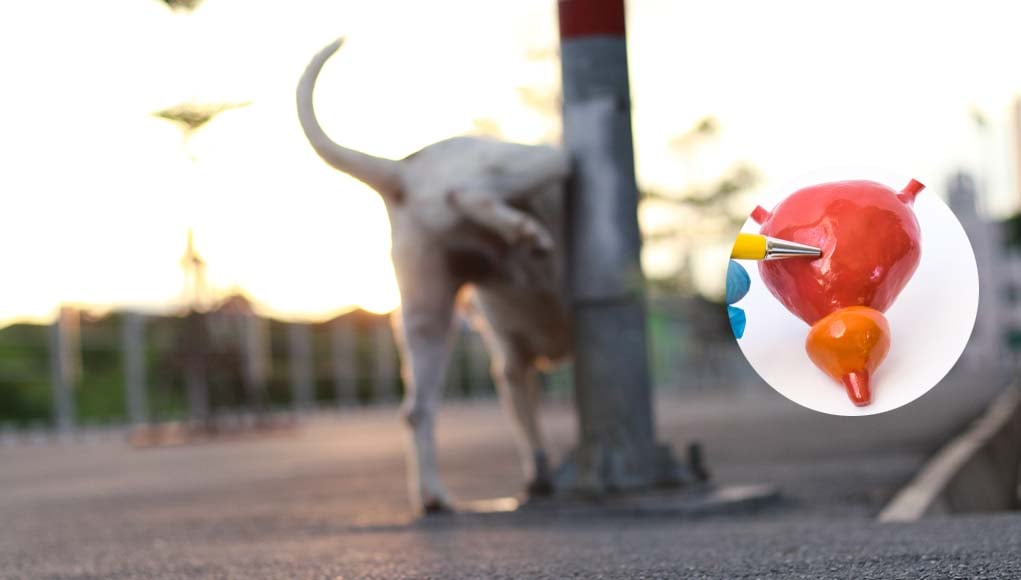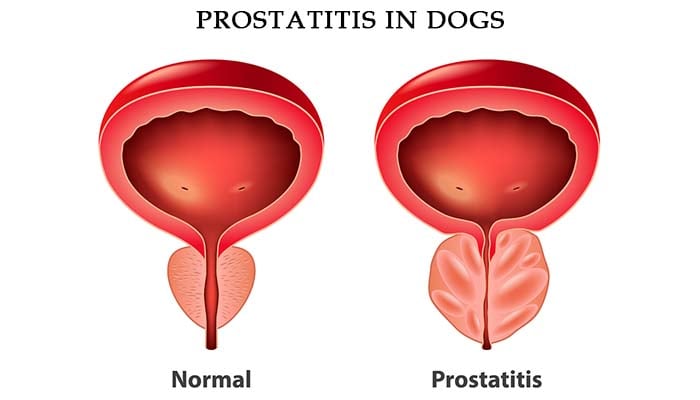An enlarged prostate is a common condition that affects men in their senior years. But men are not the exception because male dogs and other male mammals all have prostate and can thus suffer from prostate problems. These problems are mostly common in older non-fixed male dogs.
While enlarged prostate in dogs can be a health condition itself, it can also be a symptom of some other prostate disease. In this article, we will take a closer look at the prostate, the common symptoms of prostate problems in dogs, and what you can do to prevent or fix these issues.
What Is the Prostate?
The prostate is a gland found in male mammals. In dogs, it is located behind the bladder and below the dog’s rectum. The purpose of the prostate is to support and carry sperm cells. In healthy dogs, this gland reaches its maximum size when the dog reaches adulthood, which is around two years of age.
However, not all dogs have a prostate gland. If the dog gets neutered before he hits puberty, the prostate gland won’t develop. The reason for this lies in the lack of testosterone, which is the male hormone that testicles normally produce.
Signs of Prostate Problems in Dogs
Prostate problems can affect dogs of any size or breed, but they mostly occur in middle-aged and older dogs. Knowing how to spot the symptoms of prostate problems in dogs can be crucial in getting your pooch the adequate help, so let’s take a look at the most common signs of dog prostate issues.
1. Difficult or Painful Urination
This is one of the most recognizable symptoms of enlarged prostate in dogs. While difficult or painful urination as a symptom is more prominent in humans, most dogs with prostate issues will also experience this. The affected dog may spend too much time urinating and often come up with a thin urine stream.
2. Difficult or Painful Defecation
Unlike urination problems that affect some canines with prostate issues, difficult or painful defecation is a standard sign of an enlarged prostate in dogs, affecting the majority of patients. The reason lies in the fact that enlarged prostate in dogs usually pushes up on the pet's rectum, which also leads to ribbon-shaped stools.
3. Penis Discharge
Another common symptom of prostate problems is bloody discharge from the dog’s penis. You may notice a pus discharge too. However, blood in urine can also signal other health issues.
4. Abnormal Walk
Dogs with prostate issues will often have a stiff walk or walk abnormally otherwise. You may notice that your dog seems to walk like he is “walking on eggshells.” However, there are also many other reasons for your dog's behavior and odd walk.
5. Other Symptoms
Depending on the specific prostate disease or problem, you may notice some other symptoms as well that can signal prostate issues in dogs. For example, some pets may exhibit lethargic behavior or have a decreased appetite. Pain in the abdomen and fever can also occur in some cases of prostate problems.
ALSO READ: 4 Signs of Kidney Problems in Dogs (And What to Do)
How to Prevent Prostate Problems in Dogs
The best prevention of prostate problems in dogs is neutering the dog before he reaches sexual maturity. Neutering will prevent prostate gland from developing and thus prevent most of the possible health issues related to this gland.
Even if you decide to neuter your pooch after he has reached adulthood, his prostate will shrink and the risk of a prostate disease will drop significantly.
Below are some of the most common prostate problems in dogs. If you notice some of the mentioned symptoms, you need to take your pooch to the vet to get the problem diagnosed and develop a treatment plan if needed.
There are a few common conditions which can affect a dog’s prostate and we will take a look at what they are and what to do about them.
Benign Prostatic Hyperplasia (BPH)
This is the medical term for the benign enlargement of the prostate gland and it is the most common disease of the prostate in dogs. It is caused by the aging of the prostate itself, which means that this condition usually affects senior dogs.
While the Benign Prostatic Hyperplasia in dogs can cause discomfort to your pup and problems with urinating or defecating, it can often remain asymptomatic (showing no symptoms).
How to Fix It:
Most cases of BPH in dogs require no treatment. Where treatment is necessary, it usually involves castration of the animal. This will decrease the risk of recurrence and carcinoma development. Where castration is not possible, certain medications are used to shrink the prostate gland.
Prostatitis
Prostatitis is a bacterial infection of the prostate which can occur if bacteria enter the gland by traveling up the urethra. Bacteria may also enter the prostate from an infection that starts in the bladder or kidneys. E. coli is the most common culprit.
In addition to the usual signs of prostate problems, prostatitis in dogs can also cause vomiting, fever, weakness and weight loss. Severe forms of bacterial infections of the prostate can lead to prostatic abscesses.
How to Fix It:
The treatment will depend on whether the prostatitis is chronic or acute. Acute prostatitis in dogs can be a critical condition and requires a quick and aggressive reaction that usually involves IV fluids, analgesic or pain medications and antibiotics.
Chronic prostatitis in dogs is more difficult to cure completely and affected animals often have persistent problems despite therapy. The therapy includes the administration of antibiotics and regular veterinary checkups.

Prostatic and Paraprostatic Cysts
Cysts are similar to blisters but usually filled with fluid. They can develop in the prostate itself, which are referred to as prostatic cysts, or around the surface of the prostate, which are called paraprostatic cysts.
Prostatic and paraprostatic cysts in dogs slowly grow larger with time and when they become too big they put pressure on the pet's colon, rectum and urethra. Some of the symptoms include constipation, loss of appetite, lethargy, abdominal pain and painful urination or defecation.
How to Fix It:
Depending on the severity of the condition, as well as the location of either prostatic and paraprostatic cyst, usual treatments include medications, castration and surgery.
Prostatic Cancer
While prostate cancer in dogs is a rare occurrence since it accounts for 0.67% of malignancies, it is a serious, life-threatening condition. It is often associated with testicle hormones, pituitary glands and adrenal glands in the dog, but the exact causes are still unknown.
How to Fix It:
Unfortunately, in the case of dog prostatic cancer, surgery is not an option because of the location of cancer. The only options remaining are radiation therapy and chemotherapy but the statistics show that results are often poor. The average survival rate of dogs with prostatic cancer is between 2 months and 1 year.
In Summary
 Common signs of prostate problems in dogs include difficult and painful urination and defecation, discharge of blood and/or pus from the dog's penis and abnormal walking patterns.
Common signs of prostate problems in dogs include difficult and painful urination and defecation, discharge of blood and/or pus from the dog's penis and abnormal walking patterns.
Prostate problems in male dogs are a common occurrence, especially at later stages in life. Enlarged prostate affects most senior dogs, with the exception of neutered dogs. Neutering is the best way to prevent potential prostate issues.
READ NEXT: 5 Bladder Problems in Dogs – How to Recognize Them and What to Do

















